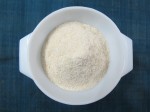Litti is roasted stuffed balls of atta. Sattu ki litti is litti stuffed with sattu. It is the classic and most common form of Litti. However, I will post recipes for other litti fillings also such as Matar ki litti, kime ki litti etc.
For the uninitiated – sattu is the powder of black chana ( gram ). It is available in most of the grocery shops in North India. Otherwise you can make it at home. Buy some Chane ka Bhuja ( i.e. roasted chana ) and grind it finely to get Sattu.I hope Bhuja is available in your market.
Now let us proceed with the Litti.
Ingredients


- Atta three cups
- Sattu one cup
- Two onions
- Garlic 5 cloves
- Ginger 1 inch
- Green chilies
- Red Chili pickle
- Lime juice 1 tea spoon
- Kalaunji
- Ajawain
- Mustard oil 1 tea spoon
- Salt
Preparing the filling
- Take one cup of Chane ka sattu in a bowl
- Add chopped onion, garlic,ginger, green chilies, kalaunji, ajawain, red chili pickle, one tea spoon of lime juice, one tea spoon of mustard oil and salt.
- Add two to three spoons of water to just moisten the sattu and rub the mixture well with your palm to give consistent mixed sattu powder.
The filling is now ready for use.
Making the Littis
- Knead atta about twice harder than for rotis.
- Make atta balls about twice the size for rotis and give it the shape of a cup with your fingers. The thickness of the walls of the cup should be about one and half times that of a roti.
- Put one or two spoons of sattu mixture into the atta cup depending upon the size of the cup.
- Seal the mouth firmly with your fingers.Traditionally the litti is of round shape. But it is more convenient if it is flattened slightly with your palms. It looks better also.
See accompanying photograph.The littis are now ready for cooking,
Cooking the Littis
The traditional method of cooking littis is roasting directly on cow dung fire or charcoal fire. But this is not practicable in modern day living conditions. Hence other methods must be followed. I will explain three methods – cooking on gas tandoor, cooking in electric oven and frying.
Cooking in gas tandoor
Best results are, of course obtained when the littis are roasted in cow dung fire. Next best results are obtained by roasting them in gas tandoor.
- Place the tandoor on medium fire and pre-heat it for a few minutes.
- Place the liitis on the wire mesh provided along with the tandoor.
- Cover the tandoor and cook on medium fire.
- Turn the littis at suitable intervals to ensure even cooking.
- Cook till some black spots appear and at least some of the littis show cracks.
High flame will burn the outer layer of the littis while leaving the inner layers uncooked. When properly cooked the litti should be crisp on the outside and soft on the inside.
Cooking in electric oven
No doubt roasting in electric oven is much less messy.
- Pre-heat the oven at 200 degrees Celsius for about five minutes.
- Place the littis on the wire mesh provided withthe oven.
- Cook for 30 to 40 minutes.
- Do not wait for black spots to appear. It may make the littis hard.
- When the cracks appear, the liitis are cooked.
Frying
Frying is another method. But the results are not as satisfying.
- The littis should first be boiled.
- Take out the littis from the water and leave them for about fifteen minutes or so to allow the water to dry.
- Fry till brown.
Even the boiled liittis served hot with chutneys etc. tase nice.
Serving Littis
Littis should be eaten hot. If the littis are roasted in a gas tandoor or an electric oven, they should be dipped in ghee immediately after roasting. Littis should be served along with one or more of its accompaniments like Chokhas ( i.e. Bhartas ), curd, chutney and pickles. Baigan chokha or baigan mixed with tomatoes goes best with littis.
Enjoy your litti.















